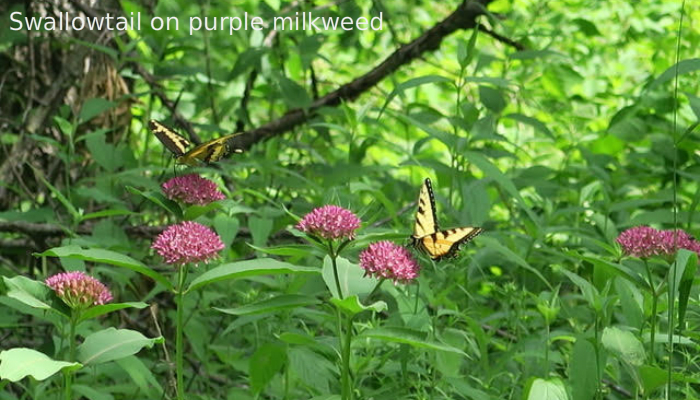My Summer Journal on Butterfly Sightings

We thought you would like to read what Sibylla Brown has taken note of in her journal in the hope that you will also be inspired to keep an eye out for the butterflies that are becoming more active now that their food sources are blooming!
Once the Purple Milkweeds, Asclepias purpurascens, came into bloom on June 4, the butterfly abundance increased. Similar in appearance to Common Milkweed but with more pointed leaves and deep rose pink flowers that turn darker as they mature, this species is a highly favored butterfly nectar source. Although it is blooming in some of our prairie openings, Purple Milkweed prefers open woodland and is considered an oak savanna indicator species. Named after Asclepius, the son of Apollo and Greek god of medicine, infusions made from pounded milkweed root were used by Native Americans to treat various ailments including pleurisy, epilepsy, kidney problems, and syphilis.
So far our best butterfly spot is in the West 40 savanna where clumps of Purple Milkweed are blooming in the sunlight filtered through the open oak canopy. There I observed Giant and Tiger Swallowtails, Dun, Hobomok and Delaware Skippers, Red Spotted Purple, Summer Azure, Great Spangled Fritillaries, and a Banded Hairstreak within a fifteen minute period.
The Banded was our first Hairstreak of the season. Common and widespread it is frequently found in dry, upland woodlands which trees provide its larval food source. The specimen I saw was perched on blackberry cane. Because of the similarity in appearance Hairstreaks can be difficult to identify to species. The Banded is distinguished by narrow bands of white-edged spots and a blue marginal patch which is not capped in orange on the underwing. Also, the marginal patch extends beyond the line of the orange marginal spots.
Also on wing were Meadow Fritillaries, Northern Cloudywings, Buckeyes and Hackberry Emperors. Of particular note were several sightings of Northern Pearly-eyes. Infrequently scattered over the southeastern half of Iowa they were flying along the West 40 bottom and woodland trails. I was disappointed not to see any Gray and Bronze Coppers or Coral and Edward’s Hairstreaks yet. They are usually on wing by mid June. Butterfly milkweed is just beginning to bloom so I expect to see them in the next couple weeks.
First of the year moths at our terrace light this period were Harnassed Tiger Moth and Hagen’s Sphinx. We’re hoping to see more diversity later this month.
Originally published in Southern Iowa Oak Savannah Alliance blog by Sibylla Brown. References: Gerould Wilhelm & Laura Rericha. 2017. Flora of the Chicago Region. Indiana Academy of Science: Indianapolis; Daniel E. Moerman.1998. Native American Ethnobotany. Timber Press: Portland


